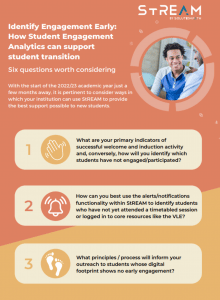
Starting University is one of the biggest life decisions a new student will have make – whether a student is joining straight from school/FE or a mature student choosing to return to education later in life. Choosing a course, an institution, accommodation, distance from home etc are all factors that will impact a student’s experience of university – and that is before they have had to enrol, make friends, join any clubs and societies and, potentially, learn to be self-sufficient.
Institutional planning of welcome and induction activities is designed to maximise success for all students during this transition period and typically begin after the welcome week activities end. A period of reflection and evaluation on the current year’s activities precedes the main planning for the new academic session, typically starting early in the new calendar year. Key features are activities to introduce students to the university, to their academic team, to the requirements of their course, to their peers and to the myriad support services available across the institution. This is a critical time for student engagement. If students are not interacting with the university at this point it could be a warning sign to a student being at risk of falling behind and even early withdrawal.
As part of delivering a successful welcome and transition for students, it is important to have quick and easy access to real-time insights into how students are beginning to navigate their way around university systems, procedures and associated processes. In particular, those insights can provide an early picture as to whether students are starting to engage with the types of educationally purposeful activities that are fundamental to attaining the higher engagement categories displayed within the StREAM student engagement analytics platform and which, according to research carried out with one of our clients, have a positive correlation with academic success.
In the early days and weeks at university, student engagement will likely be embryonic and largely behavioural in nature e.g. developing positive academic behaviours such as attending timetabled sessions. Actions like ensuring that students can log on to core university systems like the virtual learning environment (VLE) are critical activities that not only provide an insight into students’ levels of motivation and attitudes towards future learning, but also lay the foundation for ensuring that they can begin the process of online socialisation (Salmon n.d.). Learning to successfully navigate university systems is a prerequisite to increased interaction with learning that in turn will strengthen the digital learning footprint that underpins their learning analytics engagement rating in StREAM.
Starting to engender a sense of belonging is also a valuable goal for welcome and induction activity as students start to build emotional engagement with the university, their peers and their academic course teams. But this takes time to develop – certainly it won’t be accomplished at the end of welcome week. Early identification of students who have not yet logged on to the VLE in those first few weeks, followed up with a 1:1 meeting with the Personal Tutor (whether as part of a scheduled welcome activity or in addition), can help to overcome possible learning inertia and begin the process of building emotional relationships that in turn can contribute to positive affective reactions such as interest, enjoyment and belonging.
There is a reason universities only allow students to transfer course in the first two or three weeks after starting university. Typically, it is because academic experience has shown that after this time, it is incredibly difficult for students to catch up on all that has occurred during those first few weeks. This is more than just catching up on academic tasks. Students transferring into a new course after three weeks will also have missed core course information, assessment details, socialisation activities with peers. While factual detail like an assessment overview can be obtained from written sources on or within the VLE, opportunities to participate and ask questions are often not repeated meaning that the opportunity to develop emotional responses from sharing in these initial university experiences are lost.
The same reasoning can be applied to students who remain on the same course but are experiencing a lack of motivation or the social capital to engage for themselves. Research at Aston University supports this. Their research team found that students in the higher engagement quintiles within StREAM during the first 3-4 weeks after starting university were more likely to obtain the highest end-of-year marks. This finding held true even where engagement decreased over time, compared to students who started in a lower engagement quintile and then increased their engagement activity. The study concluded that early engagement behaviours are predictive of future behaviour and of future outcomes (See further Summers, Higson and Moores 2021).
Colleagues at UWE Bristol have implemented two complementary approaches to supporting students who were not engaging early in the academic year: a phone-call campaign and the use of online forms. The phone call campaign was designed initially to support Year 0 and Year 1 students living in university accommodation and who needed to self-isolate or quarantine due to the legal and regulatory framework within the UK to tackle the COVID-19 pandemic. By contrast, second- and third-year students received an email notification from StREAM containing information on sources of help and support at UWE Bristol. The email linked to an online form that, if completed, would trigger an outreach response from different colleagues at the university depending on the identified need. A separate process governing how the university would respond to form submissions enabled faster response times and an effective triaging system meant that the team could focus time and effort on those students that did need help.
During the 2021-22 academic year, a number of researchers from across the Solutionpath client base have been working as part of a WonkHE action research group to determine answers to different questions around the use and value of StREAM. We can’t give you all the details at the moment as the case studies are due to be published by WonkHE during summer 2022. What we can say is that initial findings from one research project confirm a relationship between attendance, engagement and attainment with early engagement and attendance being significant predictors of success. Not surprisingly, as engagement and attendance decrease, the likelihood of students withdrawing from their studies increases. Differences in demographic data and in protected characteristics also has an impact – which is useful in addressing attainment gaps in line with Access and Participation Plan requirements.
A different project focused on students transitioning into higher education where the shift in academic experience is the most pronounced. Findings from both research projects show that induction week to the end of week 3 are the pivotal pinch points in terms of losing students, followed by ‘wobble weeks’ during the following 3 weeks.
Members of the StREAM user community are also using early engagement alerts to send push notifications to staff or students where there has been a lack of student engagement with key resources during those first few weeks. If, for example, a student hasn’t successfully logged into the VLE by the end of week 2, that might be a reason for a check-in conversation to make sure that their IT credentials are working, that they know the importance of the information stored within the VLE and are working on any educationally-purposeful activities that will help them lay solid foundations for the year ahead – including logging in to other resources like e-journals and reading lists.
In the light of these findings, and with the start of the academic year just a few months away, it is pertinent to consider ways in which your institution can use StREAM to provide the best support possible to your new students.
Here are 6 questions we think are worth considering:

Find out how StREAM helps to provide a deeper understanding of engagement, early warning that a student may be unsure of how to get started with their academic studies and ways to activate early interventions informed by a comprehensive data-picture, on our Product page or contact us to discuss your unique university needs.
You can download these questions to use in your institution.
Salmon, G. (n.d.) The Five Stage Model [online]. Available from: https://www.gillysalmon.com/five-stage-model.html. Accessed 14/06/22
Summers, R.J., Higson, H.E. & Moores, E. (2021). Measures of engagement in the first three weeks of higher education predict subsequent activity and attainment in first year undergraduate students: a UK case study. Assessment & Evaluation in Higher Education Vol 46 (5), pp. 821-836. Also available from: https://www.tandfonline.com/doi/abs/10.1080/02602938.2020.1822282